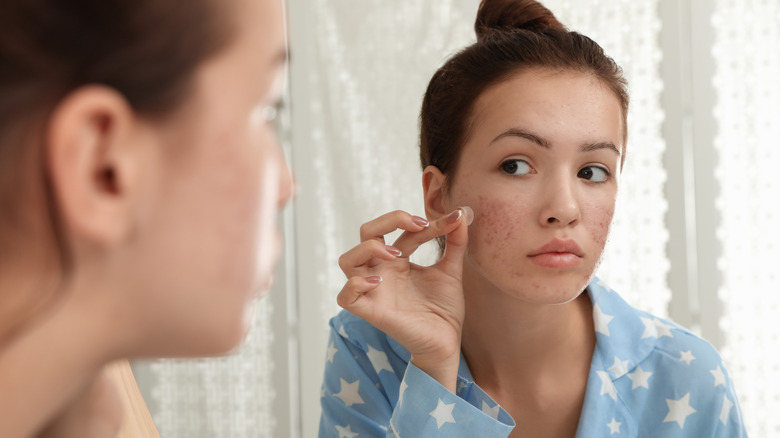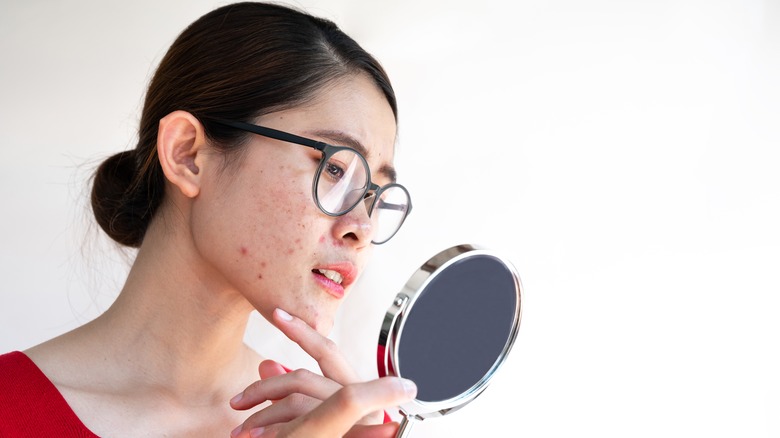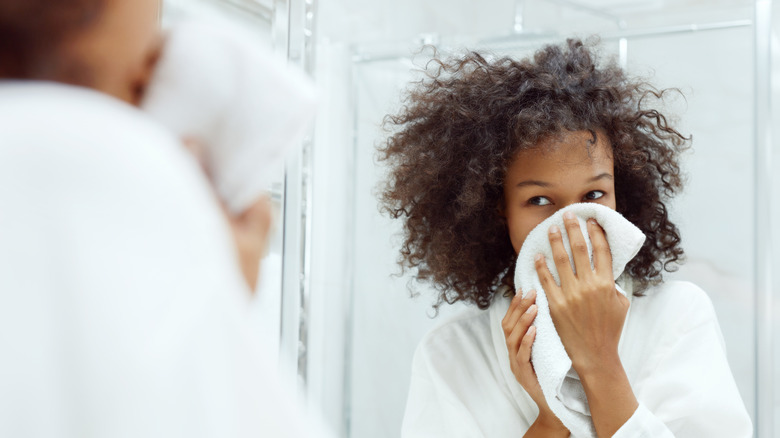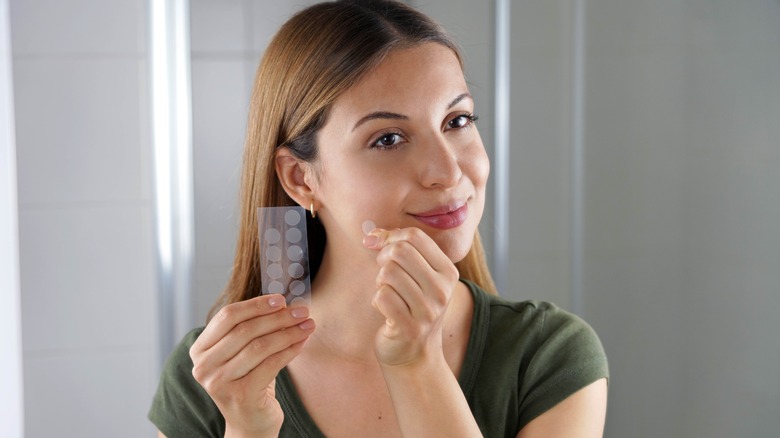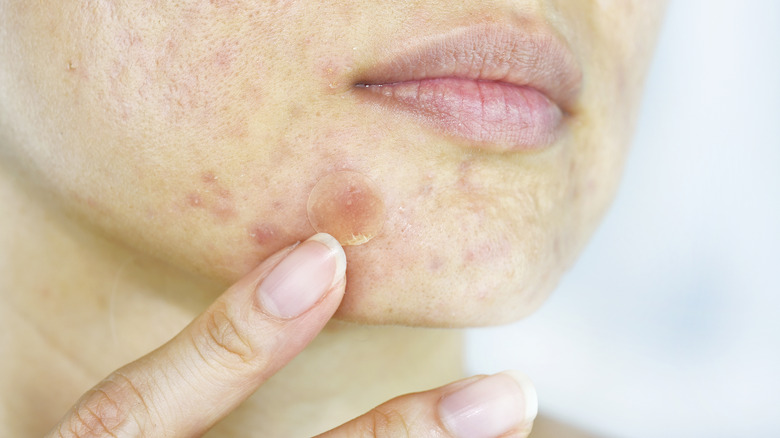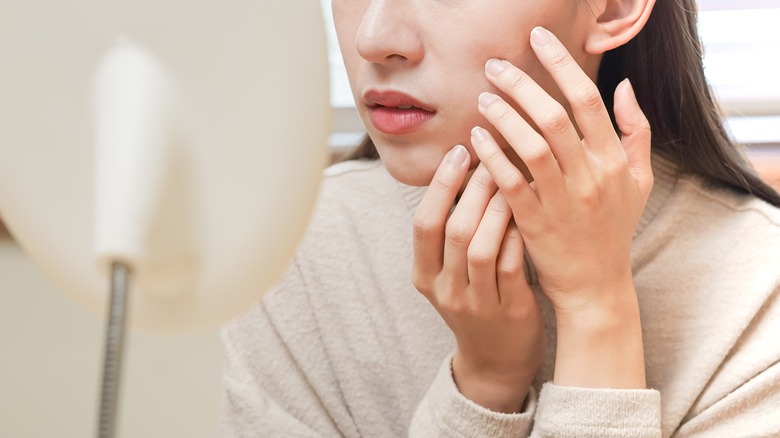Our Tips For The Perfect Use Of Pimple Patches
Among man's greatest inventions are the lightbulb, the automobile, and pimple patches. Okay, so pimple patches might not be quite that significant to society, but they're practically life-changing for people with acne. These little sticker patches go over acne blemishes, simultaneously hiding and healing your spots. "These patches are effective because they absorb excess fluid and have a vacuum-like effect that gets out any dirt and oil that could be causing a breakout," dermatologist Dr. Debra Jaliman explained to Everyday Health. "It then converts those impurities into a gel-like substance that sticks to the patch and is sealed away from the face."
The result: smaller bumps in little time and zero temptation to pick and pop. It's no wonder pimple patches are everywhere, coming in a variety of shapes, sizes, and formulations. But before you start sticking these miracle workers all over your skin, learn how they work and ways to maximize their effectiveness.
Pimple patches don't work on all blemishes
First things first: Not all acne can be treated with pimple patches. According to Healthline, standard patches rely on a hydrocolloid coating to drain pus from blemishes. If you have a pesky, oozy bump on your face, these products are perfect for offering protection while pulling out any remaining fluid. However, Korean beauty brand Wishtrend claims that pimple patches won't help early-stage pimples, where oil and pus haven't yet emerged to the superficial layers of the skin. Similarly, patches likely won't help deep cystic acne or severe breakouts. One exception is patches with micro darts that are designed to penetrate the skin, such as ZitSticka patches.
Some products contain other ingredients in addition to hydrocolloids to speed up healing and minimize inflammation. "Salicylic acid and benzoyl peroxide are always good ingredients to look for. They're staples for acne treatment," board-certified dermatologist Dr. Lavanya Krishnan, told Healthline.
Finally, don't overlook size. Many packs contain patches of varying sizes to choose from, depending on how big your pimple is. Make sure to fully cover your blemish with the sticker. If the zit is too large or raised to be covered, consider another spot treatment until it shrinks.
How to prep your skin and apply patches properly
Pimple patches are so easy to use, you can just stick one on in a pinch whenever you notice a new bump erupting on your face. But just because you can doesn't mean you should. For the best results, Wishtrend suggests first washing and thoroughly drying the skin. Water, oil, makeup, and other skincare products left on your face may prevent the patch from sticking and working properly.
If your pimple continues to leak fluid after you've washed your face, dab the spot with a clean tissue. Then, apply the patch before continuing your skincare routine with a toner or moisturizing product. Only touch pimple patches with clean fingers. Alternatively, use tweezers to peel and place patches to avoid transferring moisture from your fingers onto the sticker. Apply a little pressure to make sure the product is attached well to the skin, and voilà! You can now sit back and let the pimple patch work its magic.
Patches can be used during the day or at night
Zits don't discriminate based on the time of day — they pop up whenever they're ready. Thankfully, pimple patches can be worn during the day or overnight. Generally, these products are designed to be used whenever needed, though you may occasionally find thicker nighttime versions or thin and easy-to-hide patches meant for daytime wear. Some styles are also intended to be flaunted when you're out and about, such as these playful star-shaped patches from Starface.
If you'd rather not draw attention to your pimple patches at work or during a girls' night out, combine clear stickers with a little makeup on top. Keep foundation and concealer light — layering heavy products over the patches might just make them more visible (per Makeup.com). Additionally, be careful when rubbing or brushing cosmetics on and around the stickers, as they may slip off the skin.
Don't keep acne stickers on for too long
Different pimple patches come with different instructions on exactly how long to wear them — when in doubt, check the product label. In general, expect most stickers to require at least a few hours before they start working, according to Cleveland Clinic.
Some patches claim to be waterproof and safe to keep on for up to 24 hours, withstanding face washing, sweating, and showering. However, dermatologist Dr. Dendy Engelman urges against wearing pimple patches longer than 12 hours. "The adhesive on that patch could potentially irritate over time," she explained to Well + Good.
Your best bet is to remove pimple patches every time you cleanse your face. This eliminates any product, dirt, and oil residue that may have gotten trapped in the sticker while also giving the acne spot a chance to breathe. Then, apply a fresh patch once the skin is fully dry.
Pimple patches won't work for everyone or every situation
Pimple patches can be a trusty tool when facing sudden breakouts, but they don't work for everyone. Some people may experience adverse reactions after using hydrocolloid bandages, including pimple patches (per Healthline). For people with sensitive skin or certain allergies, the ingredients in patches may trigger rashes, itchiness, and other side effects. Immunocompromised people may also be at risk of developing skin infections when using these products.
The glue that allows pimple patches to stay in place can also cause irritation. "They do use a bit of adhesive to stick to your skin, so if you're allergic or sensitive to adhesive, this may aggravate the skin surrounding the lesion," dermatologist Dr. Amy Kassouf shared with Cleveland Clinic.
Finally, patches may not always work for those with an active lifestyle. Makeup.com recommends skipping the stickers when you hit the gym, attend a hot yoga class, or any other situation that involves breaking a sweat.
